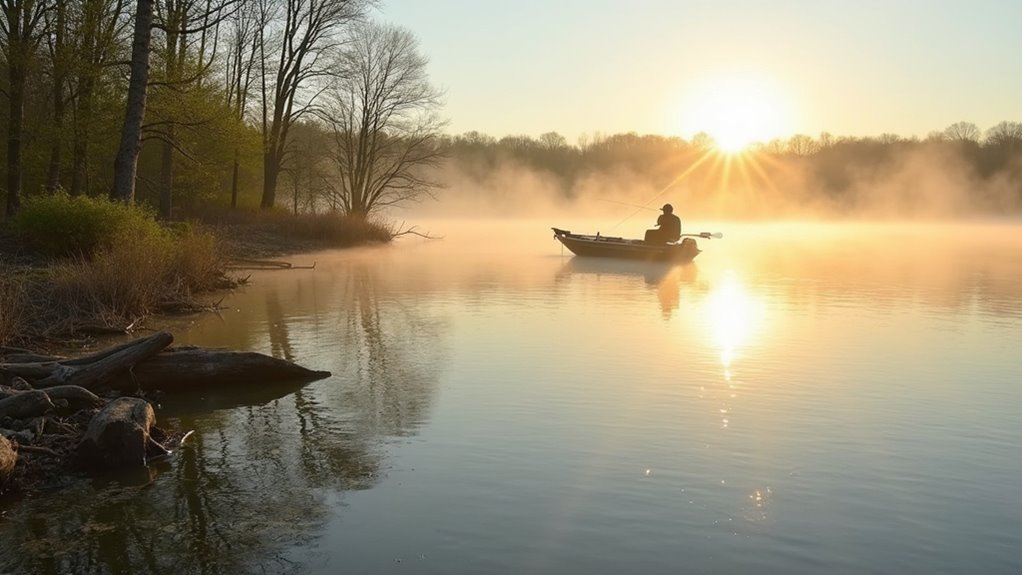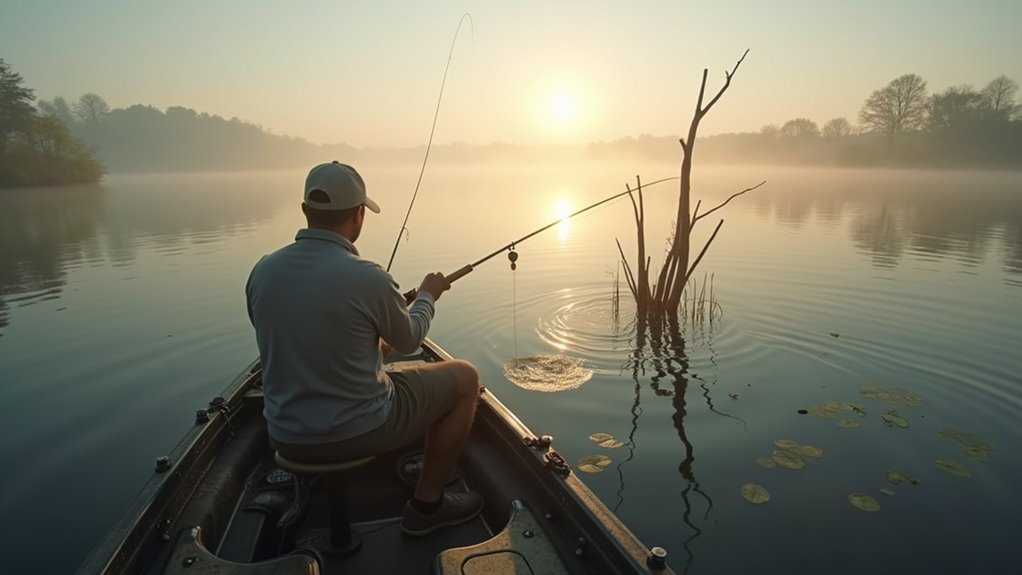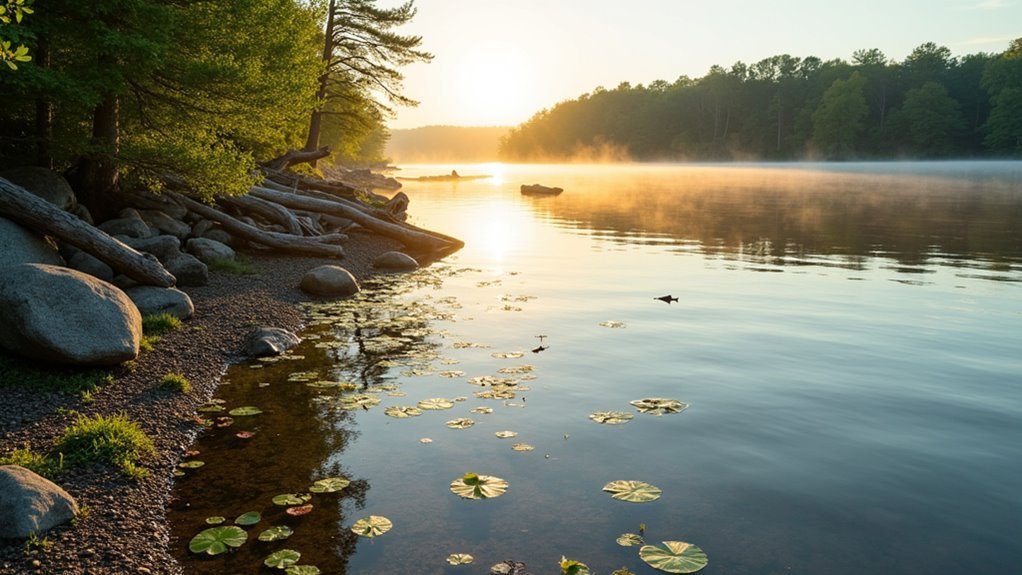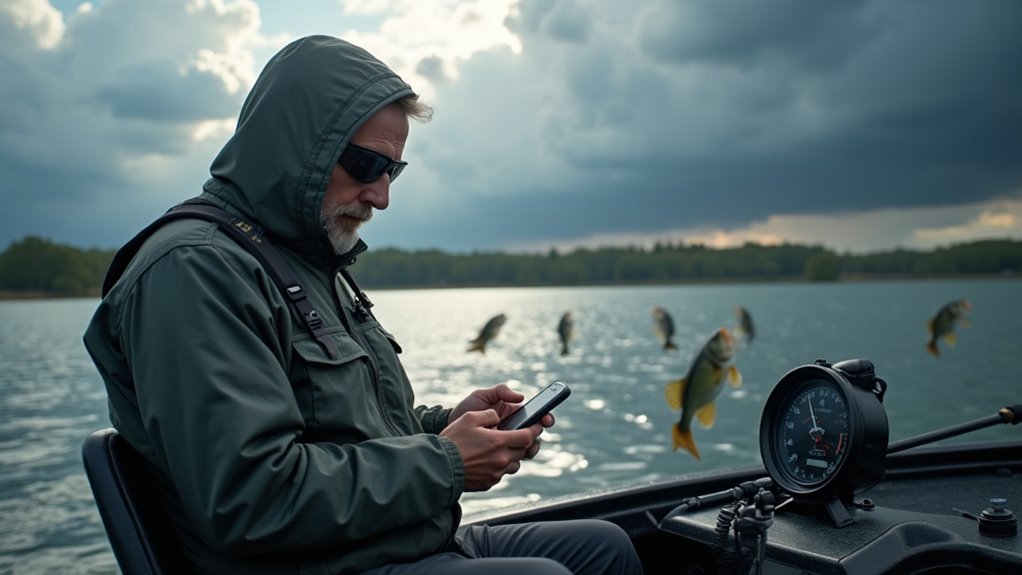To master spring bass fishing, we need to understand that bass are moving from winter depths to shallow spawning areas in early spring. We’ll catch more by downsizing lures and slowing our retrieval as bass metabolism is still sluggish below 50°F. Target changeover zones like points and channel edges, and pay attention to weather patterns—falling pressure often triggers feeding frenzies. Patience with dead-sticking jerkbaits and dragging jigs along the bottom will release those trophy catches waiting in predictable locations.
Understanding Early Spring Bass Behavior and Movement Patterns

As winter’s grip begins to loosen, bass behavior shifts dramatically, setting the stage for some of the year’s most exciting fishing opportunities. We’ve learned that bass start actively feeding around 48°F, with spawning kicking in near 57°F.
In March, these fish move from deeper winter hideouts toward shallower spawning grounds. We’ve found they follow predictable paths each year, making this shift period ideal for catching big ones.
Weather patterns play an essential role—we always check the forecast before heading out. Remember, northern lakes warm up later than southern waters, so timing varies by region. After a cold front, give the water a day to stabilize before casting your line. Additionally, having the right thrust requirements for your trolling motor can significantly improve your chances of success during this active feeding period.
Essential Lures and Gear for Spring Bass Fishing Success

Now that we comprehend when and where bass move during early spring, let’s talk about what to throw at them. In cooler water temps, you’ll need a variety of slower-action lures. We’ve found downsized offerings work best as bass metabolism isn’t fully revved up yet.
Our spring tackle box always includes jigs, crankbaits, soft plastics, and jerkbaits. Match your colors to water clarity – browns and whites shine in clear water. I remember catching a monster on a small white jig when nothing else worked!
Don’t forget to adjust your retrieval speed. We’ve learned that patience pays off – those long pauses between jerks can trigger spectacular strikes!
Slow-Retrieval Techniques That Entice Lethargic Bass

When the water hasn’t quite warmed up, slow-retrieval techniques become your secret weapon for early spring bass. These cold-water fish aren’t quick to chase, so we’ve got to tempt them with deliberate presentations that trigger their feeding instinct.
- Dead-stick technique – Let your jerkbait suspend motionless for 10-15 seconds between twitches
- Dragging jigs – Slowly pull a jig along the bottom with minimal hops
- Float-pause crankbaits – Reel just enough to feel vibration, then stop completely
- Weightless worm technique – Cast to cover and let it sink naturally with minimal movement
Locating Prime Spawning Areas and Transition Routes

Three key factors determine prime bass spawning locations: protected shallow water, stable bottom composition, and nearby deep-water access. We’ve found that bass return to the same spawning grounds year after year, making these spots gold mines once you’ve identified them.
Look for coves, backwater areas with gravel or sandy bottoms where the water warms faster. We once discovered a small bay with fallen trees that produced limits for three springs straight!
Track the routes bass take between winter holes and spawning flats. These changeover zones—like points, channel edges, and submerged roadbeds—often hold the biggest pre-spawn bass.
Adapting to Weather Changes and Barometric Pressure

Spring weather can throw more curveballs than a major league pitcher, making bass fishing particularly challenging. We’ve learned that barometric pressure greatly impacts bass behavior – often the hard way!
- Watch for falling pressure before storms, when bass typically feed more aggressively
- Expect sluggish activity during high pressure, clear-sky days
- Target deeper waters when cold fronts move through
- Use slower presentations after pressure changes
Once, we were catching bass like crazy until a front blew in. Everything stopped! We switched to deeper drop-offs with slower jig presentations and salvaged the day. Understanding weather patterns becomes your secret weapon.
Advanced Strategies for Challenging Spring Conditions
Even seasoned anglers face those frustrating spring days when nothing seems to work. We’ve all been there, staring at still lines while fish ignore our best offerings. When conditions get tough, it’s time to downsize your presentation. We’ve found that switching to lighter line and smaller baits can trigger reluctant bass.
Cold fronts demand patience. Slow your retrieve to a crawl and target junction areas where deep water meets shallow. Sometimes we’ll work the same promising spot for hours, varying our cadence until we crack the code. Remember, difficult days teach us more than the easy ones! Additionally, ensuring your trolling motor is properly maintained can significantly enhance your fishing efficiency and run time during these challenging conditions.
Frequently Asked Questions
How Does Boat Noise Affect Bass Behavior in Spring?
Boat noise can spook spring bass as they’re extra sensitive during spawning. We’ve found that reducing motor sounds, avoiding sudden movements, and drifting quietly when approaching potential beds improves our catch rates considerably.
What Time of Day Is Optimal for Spring Bass Fishing?
We’ll have the most success in early morning or late evening during spring. Bass are typically more active at dawn and dusk when water temperatures are stable and they’re actively feeding.
Is Catch-And-Release More Important During Spawning Season?
While some believe removing bass briefly doesn’t impact reproduction, we’d argue catch-and-release is especially critical during spawning. It protects vulnerable nesting females, preserves future populations, and maintains the ecological balance in our waterways.
How Does Moon Phase Influence Spring Bass Activity?
Moon phases influence bass activity in spring. We notice they feed more aggressively during full and new moons, which can trigger spawning behavior. They’re often more active and accessible during these lunar periods.
Can Bass Remember Lures They’ve Been Caught With Before?
Bass absolutely have photographic memories! We’ve seen bass refuse lures they’ve been caught on before. They’re surprisingly smart and can remember negative experiences, so we’ll catch more spring bass by regularly changing up our presentations.
Conclusion
Like gardeners nurturing seedlings through spring’s unpredictable weather, we’ve tended our fishing knowledge through countless dawns on misty lakes. We’ve shared our hard-earned secrets—reading water temperatures, choosing the right lures, and finding those hidden spawning beds. Remember, the bass fishing journey isn’t just about the catch but the seasonal dance we join. When you hook that first spring lunker, you’ll know you’ve truly joined nature’s grandest springtime celebration.